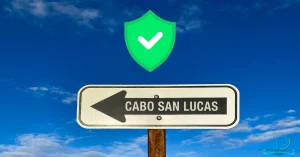| Month | Weather | Temperature | Crowds | Hotel Prices | Highlights |
|---|---|---|---|---|---|
| January | 75°F / 24°C | High | Peak Season | Whale watching | |
| February | 75-80°F / 24-27°C | High | Peak Season | Peak whale watching | |
| March | 80°F / 27°C | Very High (Spring Break) | Highest Season | Spring break | |
| April | 85°F / 29°C | Medium | High to Medium | Easter holidays | |
| May | Upper 80s°F / 31°C | Low | Medium (20-30% off) | Good deals | |
| June | 90s°F / 32-34°C | Very Low | Low | Fishing improves | |
| July | Mid-90s°F / 35°C | Low (Some families) | Low | Family vacations | |
| August | 95°F+ / 35°C+ | Low to Medium | Low | Warm ocean temps | |
| September | 90s°F / 32-35°C | Lowest of the year | Lowest of the year | Rainy season | |
| October | Upper 80s°F / 31°C | Very Low | Very Low | Fishing tournaments | |
| November | Low 80s°F / 27-28°C | Medium | Medium to High | Thanksgiving | |
| December | Mid-70s°F / 24°C | Very High | Peak Season | Holiday celebrations |
Cabo San Lucas is at the tip of Mexico's Baja California Peninsula, where the Sea of Cortez meets the Pacific Ocean.
This sunny beach town changes yearly with different weather, crowds, and prices.
Each month offers something special for visitors looking to enjoy this Mexican getaway.
January
January brings perfect weather to Cabo San Lucas with sunny days and mild temperatures.
Days hover around 75°F (24°C) with cool evenings near 55°F (13°C).
The water feels chilly at 72°F (22°C), but swimming is still enjoyable during the day.
This month marks peak tourist season after the holiday rush ends.
Hotels charge high rates, but the perfect weather makes it worth the cost for many visitors.
Booking ahead is a must since many places fill up quickly.
January offers excellent whale watching as humpback and gray whales arrive in the warm waters.
Boat tours spot these giants breaching and playing with their calves.
The clear skies and calm seas also make great sailing and fishing trips.
February
February continues the perfect weather streak in Cabo.
Sunny days with temperatures between 75-80°F (24-27°C) make beach time comfortable.
Evening temperatures stay in the upper 50s°F (14-15°C), so bring a light jacket for dinner.
The tourist crowds remain strong, especially around Valentine's Day when couples flock to Cabo for romantic getaways.
Hotel prices stay high during this peak season month.
Whale watching reaches its peak in February. Nearly every boat tour spots these fantastic creatures.
The water clarity also improves, making it a prime time for snorkeling and diving along the colorful reefs.
March
March brings the spring break crowds to Cabo San Lucas.
College students fill the beaches and nightclubs, especially in the middle of the month.
Family travelers with children on school breaks also arrive in large numbers.
Temperatures climb slightly to the low 80s°F (27-28°C) during the day.
The ocean warms up a bit more, making swimming more comfortable.
Rain remains rare, with most days offering clear, sunny skies.
Hotel rates reach their highest point during spring break weeks.
If you want a quieter visit, aim for early or late March to avoid the biggest crowds.
Booking becomes extremely important during this busy month.
April
April marks the end of the high season as spring break crowds head home.
The weather stays nearly perfect with daytime highs in the mid-80s°F (29°C) and comfortable nights.
Ocean temperatures rise to more pleasant swimming levels.
By late April, whale watching season begins to wind down as the whales start their journey north.
The Easter holiday sometimes falls in April, bringing Mexican tourists to the area for a week or two.
Hotel prices start dropping slightly from their peak season highs, especially toward the end of the month.
April offers a good balance of nice weather, smaller crowds, and better rates than the winter months.
May
May begins the shoulder season in Cabo San Lucas.
The weather warms noticeably with daytime temperatures in the upper 80s°F (31°C).
Humidity levels remain comfortable, and rain stays rare.
Tourist numbers drop significantly, giving visitors more space on beaches and at popular attractions.
Restaurant reservations become easier to get, and service often improves with less pressure on staff.
Hotel rates drop by 20-30% compared to peak season prices.
Many hotels offer special deals to attract visitors during this slower period.
May provides excellent value for travelers who want great weather without peak season costs.
June
June brings summer to Cabo, with temperatures climbing to the 90s°F (32-34°C).
The humidity starts to increase but remains lower than later summer months.
The ocean warms to very comfortable swimming temperatures.
The tourist population thins out even more, making June a quiet time to visit.
Beaches that seem crowded in winter now offer plenty of space to spread out.
Fishing conditions improve as marlin and other game fish arrive in larger numbers.
Hotel prices reach some of their lowest points of the year.
Many resorts offer significant discounts and free night promotions.
June represents one of the best value months for budget-conscious travelers.
July
July is one of Cabo's hottest months, with temperatures often reaching the mid-90s°F (35°C).
The humidity climbs, making it feel even warmer. Afternoon cool-offs in the pool or ocean become essential.
Despite the heat, July sees a small bump in visitors, especially American families on summer vacation.
Mexican tourists also arrive during their school holiday period, particularly on weekends.
Hotel rates remain relatively low despite the slight increase in visitors.
Many resorts offer summer family packages with kids-stay-free promotions.
The hot weather means fewer people on golf courses and more people in pools and ocean waters.
August
August brings the highest temperatures and humidity levels to Cabo San Lucas.
Daytime highs regularly exceed 95°F (35°C), and overnight lows stay warm at 75°F (24°C).
Brief afternoon rain showers sometimes provide relief from the heat.
Tourist numbers stay moderate with a mix of budget travelers taking advantage of low rates and families finishing summer vacations.
The ocean temperature reaches its warmest point, making water activities especially pleasant.
Hurricane season officially begins, though direct hits remain rare in Cabo.
However, the possibility of storms increases from August through October, making travel insurance more important.
September
September marks the heart of Cabo's rainy season.
While "rainy season" sounds worse than reality, short afternoon showers happen more regularly.
The month averages only about 3-4 inches of total rainfall.
This month sees the fewest tourists of the year.
Many locals take vacations during this slow period, and some smaller restaurants and shops temporarily close.
The upside is having beaches nearly to yourself on many days.
Hotel rates hit rock bottom, with some resorts offering rooms at 50-60% off peak season prices.
September provides the best deals of the year for budget travelers who don't mind the heat and slight chance of rain.
October
October brings slightly cooler temperatures as the intense summer heat begins to fade.
Daytime highs drop to the upper 80s°F (31°C) by month's end.
Humidity levels gradually decrease, making outdoor activities more comfortable.
Tourist numbers remain very low, making October another quiet month to visit.
Some fishing tournaments begin in October, bringing anglers from around the world to compete for record catches.
Hotel prices stay near their lowest levels, though they begin rising slightly toward the end of the month.
Some seasonal businesses closed during September, and will reopen as they prepare for the upcoming high season.
November
November marks the transition back to high season.
Temperatures cool to very comfortable levels in the low 80s°F (27-28°C) during the day and pleasant 60s°F (16-19°C) at night.
Humidity drops significantly, and the rainy season ends.
The tourist population grows steadily throughout the month, with a notable jump around the American Thanksgiving holiday week.
Bookings become more critical, especially for that holiday period.
Hotel rates climb back toward peak season levels by late November.
Early in the month, good deals are still available before prices increase for the winter season.
November provides an excellent balance of good weather, reasonable prices, and manageable crowd levels.

December
December brings the return of peak tourist season to Cabo San Lucas.
The weather settles into its winter pattern with daytime temperatures in the mid-70s°F (24°C) and cooler evenings requiring a light jacket.
The first half of December offers a brief window of great weather without the extreme holiday crowds.
After December 15, visitor numbers surge for Christmas and New Year's celebrations.
The town fills with festive decorations and special holiday events.
Hotel rates peak yearly during the holiday weeks, often with minimum stay requirements.
Booking several months in advance becomes necessary for this popular period.
Despite the high costs, many travelers find the perfect weather and festive atmosphere worth the premium prices.
Choosing Your Perfect Time to Visit Cabo
The best time to visit Cabo San Lucas depends on what matters most to your vacation plans.
Winter months (December-April) offer perfect weather with sunny days, mild temperatures, and peak whale watching, but come with the highest prices and biggest crowds.
Spring (May-June) provides an excellent middle ground with warm weather, low humidity, fewer tourists, and 20-30% lower hotel rates.
Summer (July-October) brings hot temperatures and some chance of rain, but rewards budget travelers with the lowest prices of the year—sometimes half of peak season costs—and nearly empty beaches.
Early November offers a sweet spot of cooling temperatures, low humidity, and good deals before winter prices kick in.
No matter which month you choose, Cabo San Lucas delivers beautiful beaches, stunning sunsets, and the relaxed Mexican hospitality that makes this destination special year-round.

